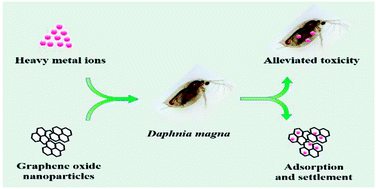Role of graphene oxide in mitigated toxicity of heavy metal ions on Daphnia magna†
Abstract
Graphene oxide (GO) is increasingly used and inevitably released into aquatic environments, facilitating its interaction with traditional pollutants such as heavy metal ions. However, the potential effect of GO on the toxicity of heavy metal ions to aquatic animals is unknown. This work aims to assess the toxicity of heavy metal ions (Cu(II), Cd(II), and Zn(II)) on Daphnia magna (D. magna) in the presence of GO. GO nanoparticles remarkably reduced the concentrations of heavy metal ions by adsorption and decreased the metal accumulation in D. magna. The maximum desorption rate of heavy metal ions from metal-adsorbed GO was below 5%. At pH 7.8, with addition of 2 mg L−1 GO, the 72 h median lethal concentration (LC50) values of Cu(II), Cd(II), and Zn(II) were increased from 14.3, 38, and 780 μg L−1 to 36.6, 72, and 1010 μg L−1, respectively. The analyses of oxidative stress indicators suggested that the oxidative damage to D. magna by heavy metal ions was reduced after addition of GO at pH 7.8. Moreover, a higher pH level in the growing range (6.5 to 8.5) of D. magna led to weaker toxicity of metal ions with GO addition due to more adsorption and less bioaccumulation. The results revealed the role of GO nanoparticles in the mitigated toxicity of heavy metal ions in the aquatic environment.



 Please wait while we load your content...
Please wait while we load your content...